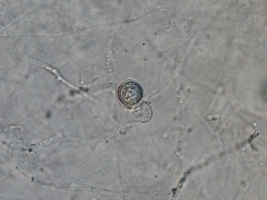
Pythium is a genus of parasitic oomycetes. They were formerly classified as fungi. Most species are plant parasites, but Pythium insidiosum is an important pathogen of animals, causing pythiosis. The feet of the fungus gnat are frequently a vector for their transmission.

Metalaxyl is an acylalanine fungicide with systemic function. Its chemical name is methyl N-(methoxyacetyl)-N-(2,6-xylyl)-DL-alaninate. It can be used to control Pythium in a number of vegetable crops, and Phytophthora in peas. Metalaxyl-M is the ISO common name and Ridomil Gold is the trade name for the optically pure (-) / D / R active stereoisomer, which is also known as mefenoxam.

Pythiaceae is a family of oomycetes. The family includes serious plant and animal pathogens in the genus Pythium. The family was circumscribed by German mycologist Joseph Schröter in 1893.
Pythium irregulare is a soil borne oomycete plant pathogen. Oomycetes, also known as "water molds", are fungal-like protists. They are fungal-like because of their similar life cycles, but differ in that the resting stage is diploid, they have coenocytic hyphae, a larger genome, cellulose in their cell walls instead of chitin, and contain zoospores and oospores.
Pythium ultimum is a plant pathogen. It causes damping off and root rot diseases of hundreds of diverse plant hosts including corn, soybean, potato, wheat, fir, and many ornamental species. P. ultimum belongs to the peronosporalean lineage of oomycetes, along with other important plant pathogens such as Phytophthora spp. and many genera of downy mildews. P. ultimum is a frequent inhabitant of fields, freshwater ponds, and decomposing vegetation in most areas of the world. Contributing to the widespread distribution and persistence of P. ultimum is its ability to grow saprotrophically in soil and plant residue. This trait is also exhibited by most Pythium spp. but not by the related Phytophthora spp., which can only colonize living plant hosts.
Pythium aphanidermatum is a soil borne plant pathogen. Pythium is a genus in the class Oomycetes, which are also known as water molds. Oomycetes are not true fungi, as their cell walls are made of cellulose instead of chitin, they are diploid in their vegetative state, and they form coenocytic hyphae. Also, they reproduce asexually with motile biflagelette zoospores that require water to move towards and infect a host. Sexually, they reproduce with structures called antheridia, oogonia, and oospores.
Pythium arrhenomanes is a plant pathogen.
Pythium graminicola is a plant pathogen infecting cereals.
Pythium myriotylum is a soil-borne oomycete necrotroph that has a broad host range, this means that it can infect a wide range of plants.
Pythium volutum is a plant pathogen infecting wheat, barley, and turfgrass. It is known to be sensitive to some of the compounds typically present in selective media commonly used for isolating Pythium spp., so isolation may require alternative methods.
Pythium dissotocum is a plant pathogen infecting strawberry and rice.
Pythium spinosum is a plant pathogen infecting a wide variety of crops. Hosts observed to be infected include rice in Taiwan, Primula, Impatiens, soil in Florida, Cucumis melo in South Korea, and soybeans in Arkansas USA, China, and Indiana USA.

Pythium sulcatum is a chromalveolate plant pathogen infecting carrots. Because this organism was once thought to be a type of fungus, it is still often treated as such.
Pythium violae is a plant pathogen infecting carrots. It is a soil-borne oomycete that causes the cavity spot disease of carrots. Pythium sulcatum also causes a less serious form of this disease. Pythium violae causes elliptical shaped brown lesions surrounded by a thin yellow halo on the surface of the taproot. These lesions cause a blemished aesthetic appearance on the carrot, reducing their market value while maintaining yield. The lesions are, on average, less than half an inch in diameter and appear near harvest, but can grow as the carrot matures and grow larger on processing varieties of carrots. Low density hyphae are present in early formation of the lesions, but there is little to no presence of Pythium violae spores in the mature lesions making it difficult to diagnose in the field. This disease can be instigated by excessive rainfall, poor soil drainage, cool temperatures, and low Soil pH. Pythium violae has been shown to infect and produce similar necrotic lesions on other hosts such as alfalfa, wheat, and broccoli. However, no economic loss has been reported from these alternate host infections.
The laimosphere is the microbiologically enriched zone of soil that surrounds below-ground portions of plant stems; the laimosphere is analogous to the rhizosphere and spermosphere. The combining form laim- from laimos denotes a connecting organ (neck) while -sphere indicates a zone of influence. Topographically, the laimosphere includes the soil around any portion of subterranean plant organs other than roots where exuded nutrients stimulate microbial activities. Subterranean plant organs with a laimosphere include hypocotyls, epicotyls, stems, stolons, corms, bulbs, and leaves. Propagules of soil-borne plant pathogens, whose germination is stimulated by a plant exudates in the laimosphere, can initiate hypocotyl and stem rots leading to "damping-off". Pathogens commonly found to cause such diseases are species of Fusarium, Phoma, Phytophthora, Pythium, Rhizoctonia and Sclerotinia.

Pythium insidiosum is a species of Pythium and a member of the class oomycota. Pythium insidiosum is mainly found in standing water and occasionally soil. Unlike most Pythium species, which are generally pathogens of terrestrial plants, Pythium insidiosum is a pathogen of mammals. It causes pythiosis, mainly in horses, dogs, and humans. It can also cause disease in cats. It is a non-transmissible disease and occurs mainly in tropical climate, endemic to Thailand, affecting mainly humans and horses and in Brazil, affecting mainly horses. Infection can occur in healthy mammals. The pathogen is well-adapted to mammalian body temperature, with an optimum temperature for growth of 34–36 °C (93–97 °F).
Pythium oopapillum is a plant pathogen, first isolated in Canada.

Stylonema alsidii is a species of marine red algae. The type locality is Trieste in Italy, but it has a worldwide distribution.
Eva Sansome, nee Richardson (1906-2001) was a British mycologist.







